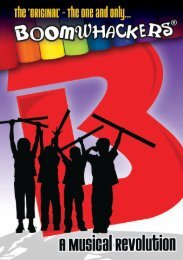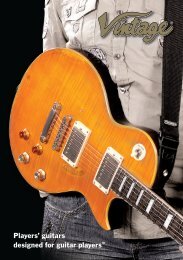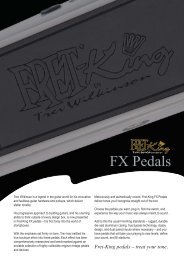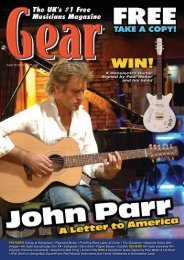GEAR 23_COVER - JHS
GEAR 23_COVER - JHS
GEAR 23_COVER - JHS
Create successful ePaper yourself
Turn your PDF publications into a flip-book with our unique Google optimized e-Paper software.
MANUEL<br />
RODRIGUEZ Sr. 1926-2008<br />
Manuel Rodríguez II, one of the finest luthiers of the Madrid<br />
school, died on December 25th 2008 in this city, where he<br />
was born in 1926. In the very early years, he started working<br />
with his father, a constructor of flamenco and classical guitars.<br />
They had their own workshop in their home, while also working<br />
in the renowned Ramírez workshop. There, legendary masters<br />
such as Jose Ramírez III taught him the love of fine woodworking<br />
using simple tools and materials and the struggle for quality in<br />
often difficult economic and political times, with only a limited<br />
availability of proper woods and other necessary materials.<br />
Flamenco singers and players would often get together at that<br />
time in the guitar workshops, playing, dancing and singing<br />
until the sun started to rise on the following day. But<br />
Rodríguez, though fond of this bohemian ambiance, was<br />
always concerned about organising a stable base from<br />
which he could produce handcrafted instruments, always<br />
striving for a strong, balanced sound from strikingly<br />
beautiful guitars.<br />
LUTHIERY SKILLS<br />
Driven to develop his luthiery skills, he emigrated to<br />
the USA under the patronage of the musician Theodore<br />
Norman. In 1959 he established himself with wife<br />
Emilia in Los Angeles, where his two boys, Manuel Jr.<br />
and Norman were born. He spent 14 years in the US,<br />
building many instruments for the lively musical world of Los Angeles<br />
and Hollywood. He also conducted research together with engineers at<br />
UCLA to improve design (bracings, frets, tieblocks, etc.). An important<br />
result was the mobile bridge for correcting the temperamental tuning<br />
challenges all guitars must deal with. He also learned English, which<br />
would prove very helpful in his later life.<br />
After returning to Spain, he soon realised that the business<br />
needed to be set on a more diverse footing, developing a<br />
dual approach constructing both fully handmade concert<br />
guitars in the workshop – where his sons received their training<br />
as luthiers – and using machines. His guitars have been praised<br />
by no less than Andres Segovia, Regino Sáinz de la Maza,<br />
Angel Romero and Theodore Norman and many others.<br />
A true family concern, the Rodriguez stable is still today<br />
located near Madrid in the Toledo province, where Manuel Sr.<br />
continued to work until just a few weeks before his death.<br />
He defined himself as '...simply a luthier and guitarmaker, neither<br />
a good nor a bad one', stressing his pride of belonging to this fine<br />
group of creators, underscoring the humility and goodwill of this<br />
master builder.<br />
Manuel Sr. is survived by his two sons, Manuel Jr. and Norman, who<br />
are both actively involved with the family company.<br />
EC does it...<br />
58<br />
An ardent guitar fan after seeing The Shadows at<br />
age 9, Alan Burridge, from Poole in Dorset, who is<br />
now 58, decided to catalogue the bands he’d seen<br />
between 1960 and 1980. This resulted in a book<br />
titled ‘Bournemouth Rocks!’ which will be available<br />
in July from Natula Publishing – details at<br />
http://www.natula.co.uk.<br />
Whilst researching the book, Alan<br />
remembered an early gig by Cream<br />
at Bournemouth’s Pavilion Ballroom<br />
in August 1966, which he missed.<br />
“I was 15, still at school and the<br />
gig took place at quite short notice.<br />
Either I was broke, unable to get<br />
to the gig on the night, or both!”<br />
he remembers. “Transport was more<br />
difficult then, and not being there was<br />
heartbreaking for a fan like myself.”<br />
To make up, he attended<br />
Cream’s legendary Royal Albert<br />
Hall ‘Farewell Concert’ in<br />
November 1968. “I adored Eric<br />
Clapton’s ‘psychedelic’ Gibson<br />
SG which he’d played since<br />
early 1967, but when he walked<br />
onstage with a Gibson ES335, I<br />
felt so disappointed. But the hippy era<br />
that that SG so beautifully represented<br />
had run its course, so Clapton did the<br />
right thing by moving on.”<br />
Recently, the local Bournemouth Daily<br />
Echo caught up on Alan’s ‘missing gig’<br />
dilemma, and tried to help find<br />
details of this elusive Cream show.<br />
“A lot of people remembered it and<br />
phoned the paper with anecdotes,”<br />
said Alan, “but the gig isn’t listed in<br />
any of the Cream biographies, so we<br />
need proof by way of a ticket stub or<br />
newspaper advert – can anyone help, please?”<br />
A lifelong guitar fan but with little self-confessed aptitude for playing<br />
them, Alan made guitars at school and always has one around his<br />
home, ‘..to have a strum on or polish!” But Clapton’s psychedelic SG,<br />
known today as ‘The Fool’ after the Dutch artists who painted it, has<br />
always been his favourite. “It is the guitar of my generation, so when<br />
I found Vintage Guitars had a tribute style guitar available I just had<br />
to have one,” he enthused. “After a heart operation in 2006, I gave<br />
up smoking and drinking and saved the money, so what better way<br />
to spend it?”<br />
The Vintage V6MRF 'Fool' is exclusive to London-based music retailer,<br />
Ivor Mairants Musicentre (0207 636 1481), who commissioned it.<br />
Each Fool guitar is hand made and hand painted, and production of<br />
this fabulous tribute instrument is very limited.

















